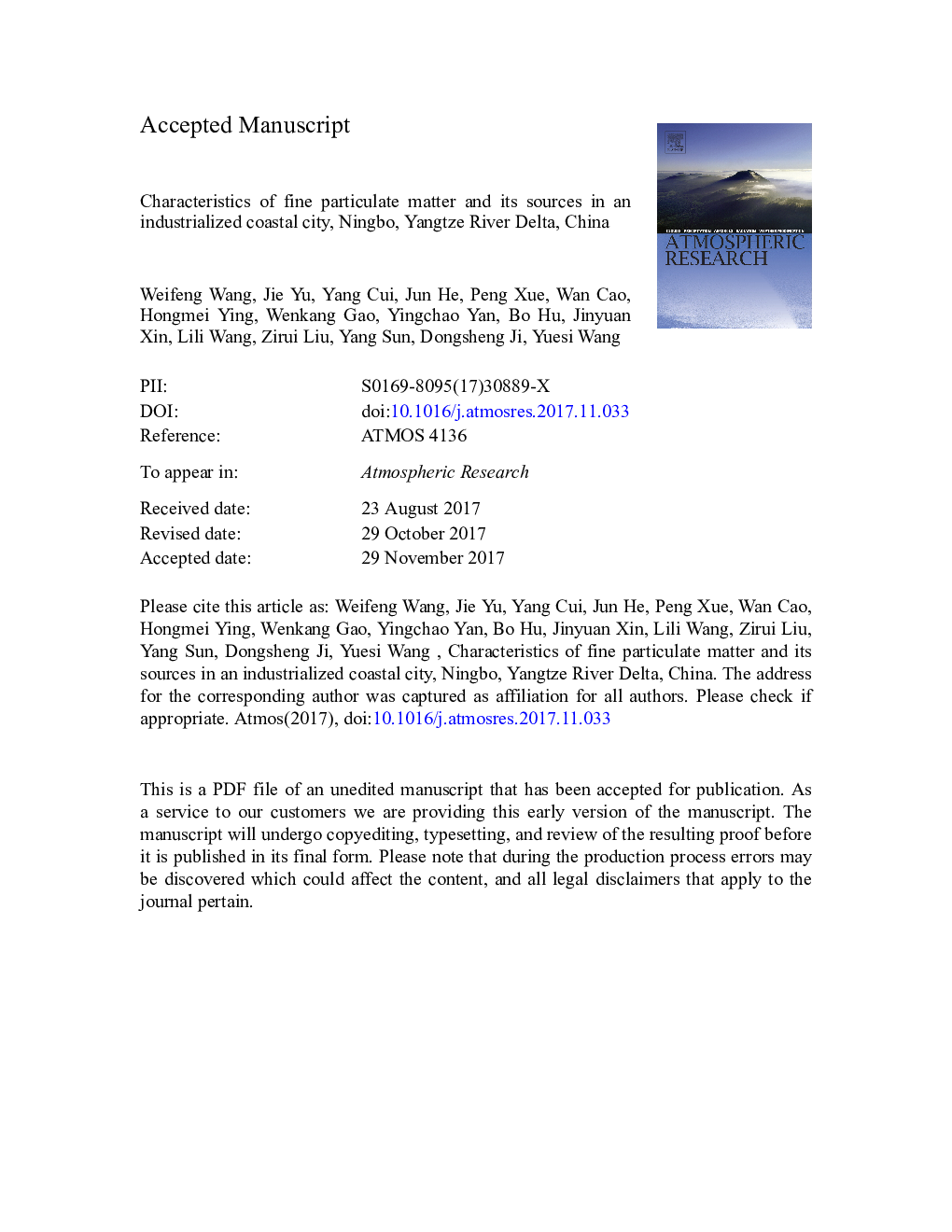| کد مقاله | کد نشریه | سال انتشار | مقاله انگلیسی | نسخه تمام متن |
|---|---|---|---|---|
| 8864753 | 1620478 | 2018 | 45 صفحه PDF | دانلود رایگان |
عنوان انگلیسی مقاله ISI
Characteristics of fine particulate matter and its sources in an industrialized coastal city, Ningbo, Yangtze River Delta, China
ترجمه فارسی عنوان
ویژگی های ذرات ریز و منابع آن در یک شهر ساحلی صنعتی، نینگبو، دلتا رودخانه یانگ تسه، چین
دانلود مقاله + سفارش ترجمه
دانلود مقاله ISI انگلیسی
رایگان برای ایرانیان
کلمات کلیدی
موضوعات مرتبط
مهندسی و علوم پایه
علوم زمین و سیارات
علم هواشناسی
چکیده انگلیسی
Chemical information is essential in understanding the characteristics of airborne particles, and effectively controlling airborne particulate matter pollution, but it remains unclear in some regions due to the scarcity of measurement data. In the present study, 92 daily PM2.5 (particulate matter with an aerodynamic diameter â¤Â 2.5 μm) samples as well as historical observation data of air pollutants were collected in urban Ningbo, one of important industrial cities in the coastal area of the Yangtze River Delta, China in autumn and winter (from Nov. 2014 to Feb. 2015). Various chemical species in PM2.5 were determined including water soluble ions, organic and elemental carbon and elements. Positive matrix factorization model, cluster analysis of back trajectories, potential source contribution function (PSCF) model and concentration-weighted trajectory (CWT) model were used for identifying sources, apportioning contributions from each source and tracking potential areas of sources. The results showed the PM2.5 concentration has been reducing; nonetheless, the concentrations of PM2.5 are still much higher than the World Health Organization guideline with high PM2.5 concentrations observed in autumn and winter for the past few years. During the sampling period, the average PM2.5 mass concentration was 77 μg/m3 with the major components of OC, NO3â, SO42 â, NH4+ and EC, accounting for 24.7, 18.8, 14.5, 11.8 and 6.4% in the total mass concentration, respectively. When the aerosol pollution got worse during the sampling period, the NO3â, SO42 â and NH4+ concentrations increased accordingly and NO3â appeared to increase at fastest rate. SO42 â transported from industrial areas led to slight difference in spatial distribution of SO42 â in Ningbo. More secondary organic carbon was formed and the enrichment factor values of Cu, Ag, Cd, Sn and Pb increased with the degradation of air quality. Ten types of sources were identified for PM2.5 in the autumn and winter of Ningbo, which are metallurgical industry, biomass burning and waste incineration, manufacturing related with Mo, chlor-alkli chemical industry, oil combustion, vehicular emission, secondary source, soil dust, road dust and manufacturing related with Cr, accounting for 9.4, 4.8, 9.4, 7.6, 8.1, 18.7, 27.6, 2, 7.1 and 5.2% of the total sources, respectively. There were five groups of air parcels arriving in Ningbo, of which inland air masses originating from Shandong province were associated with the highest PM2.5 concentrations. Despite the slight differences, it was obvious that the north of Jiangxi, east of Anhui, west of Jiangsu, south of Shandong were identified as major potential sources-areas of SO42 â, NO3â, NH4+, Clâ, OC and EC by both PSCF and CWT models.
ناشر
Database: Elsevier - ScienceDirect (ساینس دایرکت)
Journal: Atmospheric Research - Volume 203, 1 May 2018, Pages 105-117
Journal: Atmospheric Research - Volume 203, 1 May 2018, Pages 105-117
نویسندگان
Weifeng Wang, Jie Yu, Yang Cui, Jun He, Peng Xue, Wan Cao, Hongmei Ying, Wenkang Gao, Yingchao Yan, Bo Hu, Jinyuan Xin, Lili Wang, Zirui Liu, Yang Sun, Dongsheng Ji, Yuesi Wang,
